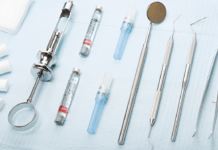I graduated from Northern Arizona University’s dental hygiene program in May 1997, following my father’s footsteps into a career as a dental hygienist. When I first started, I moved around a lot, trying to get settled with my young family. I finally ended up in my hometown, working in an office with my dad. The town had maybe a dozen dental hygienists, and, in a rare occurrence, three of us were men.
I have often wondered why more men didn’t go into dental hygiene. I believe that I at least got a partial answer during my time in private practice. The power of identifying with someone doing a job has huge implications.
The truth of this became apparent over the years. By the time I left private practice 17 years later, eight male dental hygienists were in a community of under 20,000 people ─ a number much higher than the national average. The men were not necessarily there because of anything my dad or I did, but I believe it helped that they were able to identify with us and visualize themselves in a similar role.
An early job in dental hygiene was working in a large retirement location in Arizona. I worked with an amazing dentist who happened to be female. It was almost impossible to convince our patient base that she was the dentist and I was the hygienist. Patients would ask me why the assistant checked my work, and I would reinforce that she was the dentist.
Afterward, they would get out of my chair and say, “Thank you, doctor.” She had a pretty good attitude about it, but it was still uncomfortable. To that generation, it just didn’t make any sense. Luckily, times have changed, at least for dentists.
Diversity Should Include Men … And Tattoos
I am now in dental hygiene education, and I am even more convinced that the profession needs more men. It’s not because men will make anything better. Let’s be honest; they mostly don’t. It is because true diversity makes things better. In the same way, more women dentists were better for the profession and society in general. Not only are there not enough Black men, Asian men, or Hispanic men, males make up only about 4% of all dental hygienists, period.1
I believe that diversity should look like a sampling of our society, and that is why I am also OK with tattoos and different hair colors. I have found many who disagree with me about what future dental hygienists should look like or about the importance of this kind of diversity within the profession. They believe that diversity is only about demographic information, but it is much more complex than that.
True diversity is inclusive and changes with the times. It is nearly impossible to look back into history and find a time when people were singled out and excluded that isn’t disturbing by using today’s values. It is commonplace for the old guard to think that younger generations are going about things all wrong. Their music is horrible, their clothing appalling, and what the hell is going on with their hair?
What Should We Look Like, Eh?
So, what should a dental hygienist look like? If having tattoos is unprofessional, does that include tattoos that are a very important part of someone’s culture? Who gets to tell that person that they should be ashamed of their tattoos and cover them up because they don’t fit the part?
Professionalism is defined by the Merriam-Webster Dictionary as “the conduct, aims or qualities that characterize a profession or professional person.”2 A document provided by The U.S. Department of Labor states, “Professionalism does not mean wearing a suit or carrying a briefcase; rather, it means conducting oneself with responsibility, integrity, accountability, and excellence.”3
Does a tattoo negate your ability to act and appear professional? The subject matter would seem to be important in this example. How about hair color?
Before I received a kidney transplant in 2008, I could not get insurance because I had a preexisting condition diagnosed in high school. My blood pressure was through the roof, and my kidneys were failing fast, but not as fast as my bank account. Health care is extremely expensive, and I was unable to do everything that I needed to do. In the years immediately preceding my transplant, I was lucky enough to find a health care provider who took care of me, regardless. He helped me with medication samples whenever he could.
He was a lifesaver, literally. He also had a huge beard, was covered in tattoos, and drove a Harley Davidson motorcycle. He served two tours in Vietnam as a field medic too. Was he somehow less professional than his colleagues? He was a registered nurse and a physician’s assistant.
He represents the perfect example of the kind of diversity about which I am talking. Demographically he is a white male, not really what I would call diverse. Yet, he still did not look the part of a traditional health professional. Without his professionalism, I do not know what I would have done.
I am not saying that I am right. I am also not implying that there are not concerns that can be debated. I am suggesting that the discussion should not be shut down by those using the guise of tradition or professionalism.
It is OK to ask questions and reevaluate one’s perception. It is important to be lifelong learners, and that includes reevaluating social norms and prejudices. It is important to ask questions such as “What does diversity look like?”
Should the dental hygiene profession actively work toward creating a more inclusive group of graduating dental hygienists? If you compare a picture of a graduating class from dental school today with one from 30 years ago, you will see radical changes in diversity. Is that true for dental hygienists?
Why is it still so easy to picture in your mind what a dental hygienist looks like?
Before you leave, check out the Today’s RDH self-study CE courses. All courses are peer-reviewed and non-sponsored to focus solely on high-quality education. Click here now.
Listen to the Today’s RDH Dental Hygiene Podcast Below:
References
- 2018-19 Survey of Allied Dental Education. (2020, January). Commission on Dental Accreditation. Retrieved from https://www.ada.org/~/media/ADA/Science%20and%20Research/HPI/Files/SALL_DH_2018-19.xlsx?la=en
- Professionalism. (n.d.). Merriam-Webster Dictionary. Retrieved from https://www.merriam-webster.com/dictionary/professionalism
- Skills to Pay the Bills: Mastering Soft Skills for Workplace Success. (n.d.). U.S. Department of Labor. Retrieved March 22, 2021, from https://www.dol.gov/sites/dolgov/files/odep/topics/youth/softskills/professionalism.pdf












